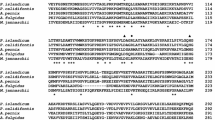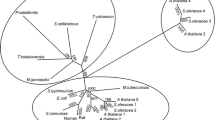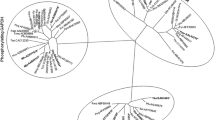Abstract
Genome sequence of Pyrobaculum calidifontis, a hyperthermophilic archaeon, harbors three open-reading frames annotated as alcohol dehydrogenases. One of them, Pcal_1311, does not display a significantly high homology with any of the characterized alcohol dehydrogenases. Highest homology of 38% was found with the characterized counterpart from Geobacillus stearothermophilus. To examine the biochemical properties of Pcal_1311, we have cloned and functionally expressed the gene in Escherichia coli. Purified recombinant Pcal_1311 catalyzed the NAD(H)-dependent oxidation of various alcohols and reduction of aldehydes, with a marked preference for substrates with functional group at the terminal carbon. Highest activity for the oxidation reaction (3 μmol min−1 mg−1) was found with 1,4-butanediol and for the reduction reaction (150 μmol min−1 mg−1) with glutaraldehyde. Both the oxidation and reduction activities increased with the increase in temperature up to 80 °C. Recombinant Pcal_1311 was highly stable and retained more than 90% activity even after incubation of 180 min at 90 °C. In addition to the thermostabilty, Pcal_1311 was highly stable in the presence of known denaturants including urea and guanidine hydrochloride. The high stability, particularly thermostability, and the NADH-dependent aldehyde reduction activity make Pcal_1311 a unique member in the alcohol dehydrogenase family.





Similar content being viewed by others
References
Anbu P, So JS, Hur BK, Yun HS (2016) Organic solvent stable protease isolation and characterization from organic solvent tolerant strain of Lysinibacillus sphaericus PAP02. Biologia 71:972–979
Bottoms CA, Smith PE, Tanner JJ (2002) A structurally conserved water molecule in Rossmann dinucleotide-binding domain. Protein Sci 11:2125–2137
Bradford M (1976) A rapid and sensitive method for the quantitation of microgram quantities of protein utilizing the principle of protein dye binding. Anal Biochem 72:248–254
Chohan SM, Rashid N (2013) TK1656, a thermostable L-asparaginase from Thermococcus kodakaraensis, exhibiting highest ever reported enzyme activity. J Biosci Bioeng 116:438–443
Doukyu N, Ogino H (2010) Organic solvent-tolerant enzymes. Biochem Eng J 48:270–282
El-Kabbani O, Carbone V, Darmanin C, Oka M, Mitschler A, Podjarny A, Schulze-Briese C, Chung RP (2005) Structure of aldehyde reductase holoenzyme in complex with the potent aldose reductase inhibitor fidarestat: implications for inhibitor binding and selectivity. J Med Chem 48:5536–5542
Fraser CM, Eisen JA, Salzberg SL (2000) Microbial genome sequencing. Nature 406:799–803
Gharib G, Rashid N, Bashir Q, Gardner QA, Akhtar M, Imanaka T (2016) Pcal_1699, an extremely thermostable malate dehydrogenase from hyperthermophilic archaeon Pyrobaculum calidifontis. Extremophiles 20:57–67
Goswami P, Chinnadayyala SSR, Chakraborty M, Kumar AK, Kakoti A (2013) An overview on alcohol oxidases and their potential applications. Appl Microbiol Biotechnol 97:4259–4275
Guagliardi A, Martino M, Iaccarino I, De Rosa M, Rossi M, Bartolucci S (1996) Purification and characterization of the alcohol dehydrogenase from a novel strain of Bacillus stearothermophilus growing at 70 °C. Int J Biochem Cell Biol 28:239–246
Gupta A, Khare SK (2009) Enzymes from solvent-tolerant microbes: useful biocatalysts for non-aqueous enzymology. Crit Rev Biotechnol 29:44–54
Liliensiek AK, Cassidy J, Gucciardo G, Whitely C, Paradisi F (2013) Heterologous overexpression purification and characterisation of an alcohol dehydrogenase (ADH2) from Halobacterium sp. NRC-1. Mol Biotechnol 55:143–149
Machielsen R, Uria RA, Kengen WM, Oost J (2006) Production and characterization of a thermostable alcohol dehydrogenase that belongs to the aldo-keto reductase superfamily. Appl Environ Microbiol 72:233–238
Moore CM, Minteer SD, Martin RS (2005) Microchip-based ethanol/oxygen biofuel cell. Lab Chip 5:218–225
Nelson KE, Paulsen IT, Heidelberg JF, Fraser CM (2000) Status of genome projects for nonpathogenic bacteria and archaea. Nat Biotechnol 18:1049–1054
Radianingtyas H, Wright PC (2003) Alcohol dehydrogenases from thermophilic and hyperthermophilic archaea and bacteria. FEMS Microbiol Rev 27:593–616
Rashid N, Imanaka H, Kanai T, Fukui T, Atomi H, Imanaka T (2002) A novel candidate for the true fructose-16-bisphosphatase in archaea. J Biol Chem 277:30649–30655
Rasool N, Rashid N, Iftikhar S, Akhtar M (2010) N-terminal deletion of Tk1689 a subtilisin-like serine protease from Thermococcus kodakaraensis copes with its cytotoxicity in Escherichia coli. J Biosci Bioeng 110:381–385
Reid MF, Fewson CA (1994) Molecular characterization of microbial alcohol dehydrogenases. Crit Rev Microbiol 20:13–56
Tanaka N, Kusakabe Y, Ito K, Yoshimoto T, Nakamura KT (2002) Crystal structure of formaldehyde dehydrogenase from Pseudomonas putida: the structural origin of the tightly bound cofactor in nicotinoprotein dehydrogenases. J Mol Biol 324:519–533
Vitale A, Rosso F, Barbarisi A, Labella T, D’Auria S (2010) Properties and evolution of an alcohol dehydrogenase from the crenarchaeota Pyrobaculum aerophilum. Gene 46:26–31
Woodyer RD, Johannes TW, Zhao H (2006) Regeneration of cofactors for enzyme biocatalysis. In: Pandey A, Webb C, Soccol CS, Larroche C (eds) Enzyme technology, Asiatech Publishers Inc, New Delhi, pp 83–101
Ying X, Ma K (2011) Characterization of a zinc-containing alcohol dehydrogenase with stereoselectivity from the hyperthermophilic archaeon Thermococcus guaymasensis. J Bacteriol 12:3009–3019
Author information
Authors and Affiliations
Corresponding author
Additional information
Communicated by H. Atomi.
Electronic supplementary material
Below is the link to the electronic supplementary material.
Rights and permissions
About this article
Cite this article
Ashraf, R., Rashid, N., Kanai, T. et al. Pcal_1311, an alcohol dehydrogenase homologue from Pyrobaculum calidifontis, displays NADH-dependent high aldehyde reductase activity. Extremophiles 21, 1101–1110 (2017). https://doi.org/10.1007/s00792-017-0970-y
Received:
Accepted:
Published:
Issue Date:
DOI: https://doi.org/10.1007/s00792-017-0970-y




